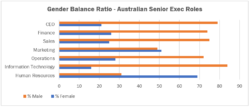17th September 2020
Gender Balance: Is it Necessary? Is it Achievable?
I couldn’t help but ponder those questions as I kicked off some research to help a client with some market intelligence to support their external succession planning. Right up front I’m asking for your comments and input. Have you achieved gender balance in your organisation? If so, has it had a material impact on gender equality? Or on gender pay parity? All comments and insights are welcome.
Market Intelligence helps organisations see where they stand relative to their competition in key areas. Improving gender balance at senior levels is one area we regularly get asked to investigate.
The table below is the snapshot of the Australian market for senior executives that I started with for this assignment.
The size of the challenge is clear.
Working to a rule of thumb of gender balance being at least 40% of one gender. As of September 2020, only one classification of senior level executive is gender balanced, Marketing.
The Caveat
This is a high-level Australia-wide snapshot of organisations, public and private, large and small. It doesn’t include every executive level function. It may look very different if we were to focus on your industry and those industries adjacent to yours. Gender balance might also look very different at lower levels of organisations. Additionally, it’s important to note that we are looking at gender balance not gender equality.
Hence the initial question. Are gender balance and gender equality correlated? Is there a causal relationship? Or are they mutually exclusive concepts?
According to Australia’s Workplace Gender Equality Agency (WGEA) “gender equality is achieved when people are able to access and enjoy the same rewards, resources and opportunities regardless of gender. The gender gap in the Australian workforce is still prevalent. Women continue to earn less than men. Are less likely to advance their careers as far as men, and accumulate less retirement or superannuation savings.”
The WGEA reporting data from 2018 also shows that representation of women steadily declines with seniority. So, most senior levels of management are heavily male-dominated, and men hold the majority of leadership roles. Even in female-dominated industries.
The 2020 census of ASX200 companies by the organisation Chief Executive Women has identified:
- The number of female CEOs is at its lowest level since the census began four years ago, with 10 women occupying the top job among ASX200 companies, compared to 11 in 2017.
- The number of companies with no women in “line” roles, senior employees accountable for profit and loss statements (CEO feeder jobs), has increased from 57% to 65%. By comparison, there is only one ASX200 company that does not have any men in these roles.
If You Only Had One Choice
To boil it down to a binary question. If you had to choose one path to close the pay, career and savings gaps between women and men would you:
- Continue the incremental improvements being achieved through gender equality activities, or
- Change the focus to achieving gender balance, in the belief that getting more women into senior roles in more functions, in more organisations would increase the rate of change.
Additional Questions to Consider:
- Is gender balance a priority or a ‘nice to have’ for your organisation?
- If it is a priority how does your organisation stack up at senior levels?
- If you are not meeting your aspirations on gender balance do you believe your internal talent pipeline and talent development agenda have you on track to achieve balance in the mid-term?
- If not, is your organisation attractive to the best people from other organisations?
The Reality
It’s a numbers game. There is a finite number of women available. The number varies by the type of industry and type of role. Also, based on WGEA and Chief Executive Women data it’s hard to see the gender balance changing anytime soon at a national level.
But that does not need to be the case for your organisation.
If your organisation is seeking to achieve gender balance as one part of your gender equality and Diversity and Inclusion efforts, and your talent and succession pipelines of women don’t guarantee you will get there automatically, the action required is simple. You are going to have to recruit women from other organisations. But as we like to say, ‘simple ain’t easy.’
As I mentioned above, I’d love to see thoughts and ideas on this important topic. Of course if you are interested in gathering market and competitive intelligence to plan key moves to improve gender balance or indeed any other aspect of talent and capability, I would be happy to discuss further.
Categories: General




